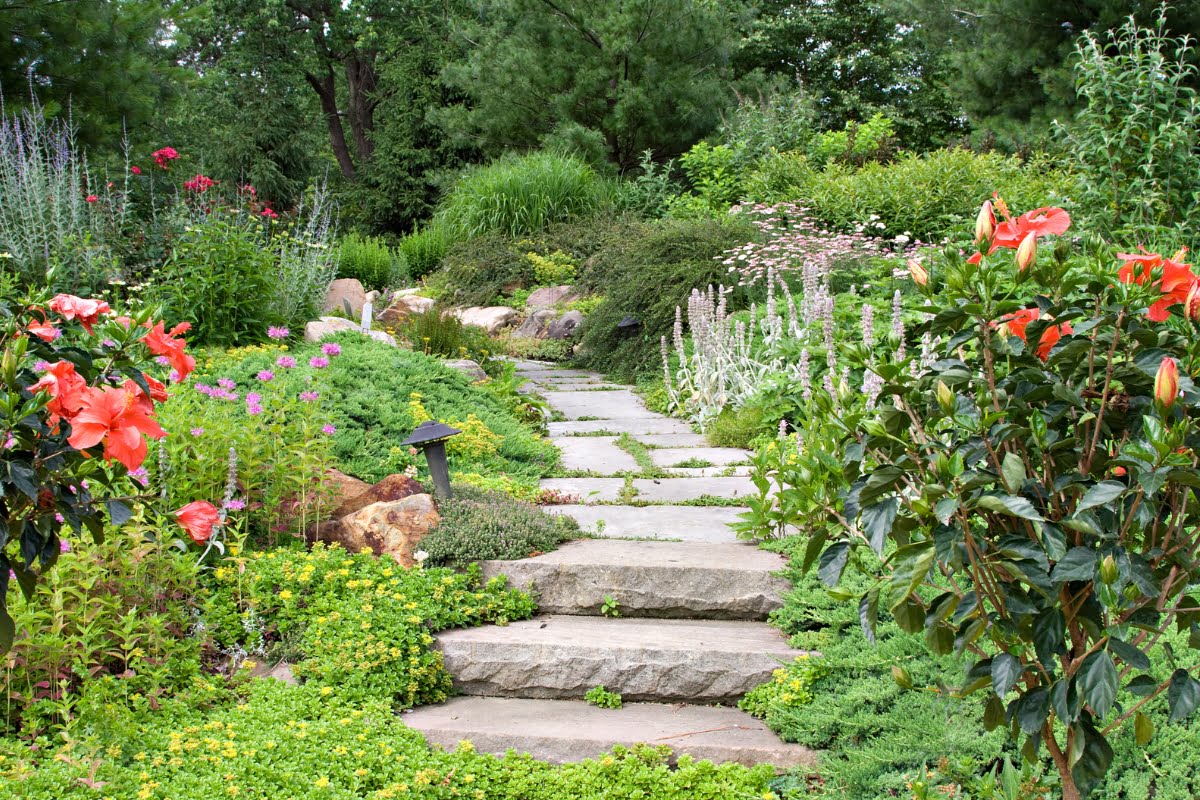Are you ready to transform your backyard into a captivating oasis? If you’ve been yearning to create a stunning garden path in your yard, you’ve come to the right place. In this blog post, we will delve into the world of landscape design and explore ten inspiring ideas in building a garden path that will elevate your outdoor space to new heights.
Join us on this journey as we unlock the secrets to creating a stunning garden path that will leave your guests in awe. Let’s dive into the world of landscape design and discover how you can transform your yard into a captivating sanctuary. So grab your gardening gloves and get ready to embark on an adventure filled with inspiration and beauty!
Designing Your Dream Path: Building a Garden Path That Inspires
Classic Cobblestones: Adding Timeless Elegance to Your Garden Path
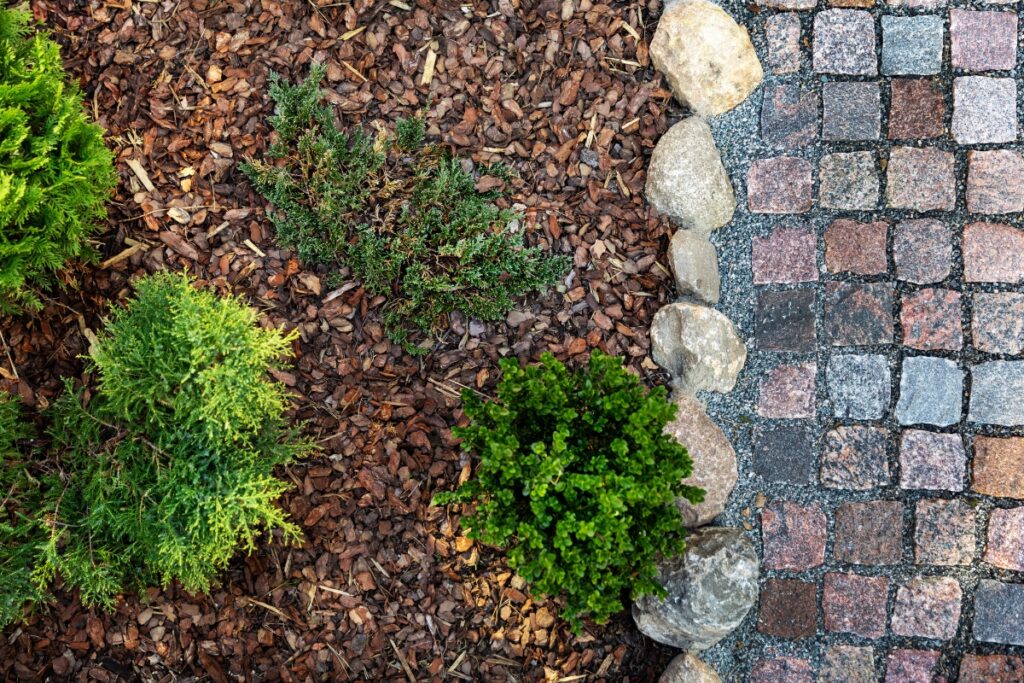
When it comes to building a stunning garden path, classic cobblestones are a timeless choice that never goes out of style. These small, rounded stones have been used for centuries to create charming and elegant pathways that exude a sense of history and tradition.
Cobblestones come in various sizes and colors, allowing you to customize your garden path to suit your personal taste and the overall aesthetic of your yard. Whether you opt for a uniform pattern or a more random arrangement, cobblestones add texture and visual interest to any outdoor space.
One of the advantages of using cobblestones is their durability. These stones are incredibly sturdy and can withstand heavy foot traffic without losing their charm. They also age beautifully, developing a weathered patina over time that only enhances their appeal.
To build a garden path with cobblestones, start by preparing the ground. Remove any existing vegetation or debris and level the area. Then, lay down a base layer of compacted gravel or sand to provide stability for the stones.
Next, arrange the cobblestones in your desired pattern, making sure they fit snugly together. Fill in the gaps between the stones with sand or gravel, sweeping it into place until it is level with the tops of the cobblestones.
To maintain your cobblestone pathway, periodically sweep away debris and weeds that may accumulate between the stones. You can also use a pressure washer to remove dirt and grime if necessary.
With classic cobblestones as your building material, you can create a garden path that exudes elegance and sophistication. Whether you have a traditional English garden or a modern minimalist landscape, this timeless choice will add character and charm to your outdoor space.
Whimsical Stepping Stones: Creating a Quirky and Charming Trail
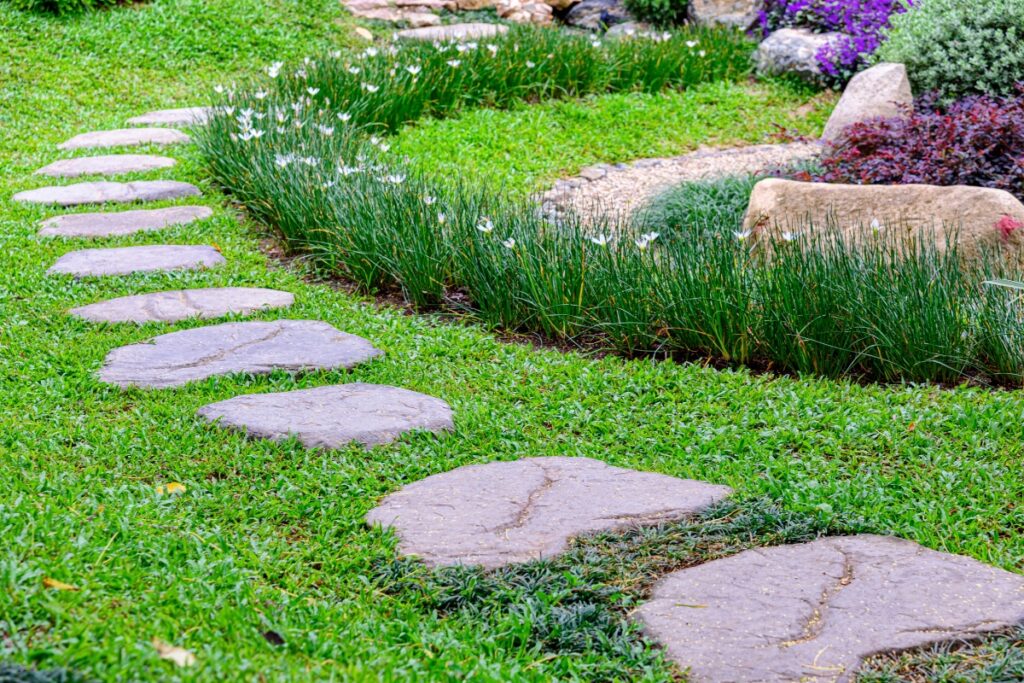
If you’re looking to infuse your garden path with a touch of whimsy and charm, consider using stepping stones. These flat stones come in various shapes, sizes, and colors, allowing you to create a unique and playful trail through your yard.
Stepping stones can be made from natural materials such as slate, flagstone, or even recycled materials like broken ceramic tiles. They can also be purchased pre-made or crafted by hand for a more personalized touch.
When designing your stepping stone path, think outside the box. Instead of a straight line, consider creating a meandering trail that adds intrigue and invites exploration. You can place the stones at different angles or heights to create visual interest and make the journey more exciting.
To install stepping stones in your garden path, start by preparing the ground. Remove any vegetation or debris and level the area. Then, dig holes slightly larger than the size of your stones and fill them with sand or gravel for stability.
Next, place the stepping stones in their designated spots, making sure they are secure and level. You can add decorative elements such as pebbles or moss between the stones to enhance their whimsical appeal.
Maintaining a garden path with stepping stones is relatively easy. Regularly sweep away debris and remove any weeds that may grow between the stones. If desired, you can also use a mild detergent solution to clean the surface of the stones.
A garden path adorned with whimsical stepping stones is sure to delight both young and old alike. It adds an element of playfulness to your outdoor space while providing functionality and guiding visitors through your yard in style.
Natural Stone Pavers: Embracing the Beauty of Mother Nature
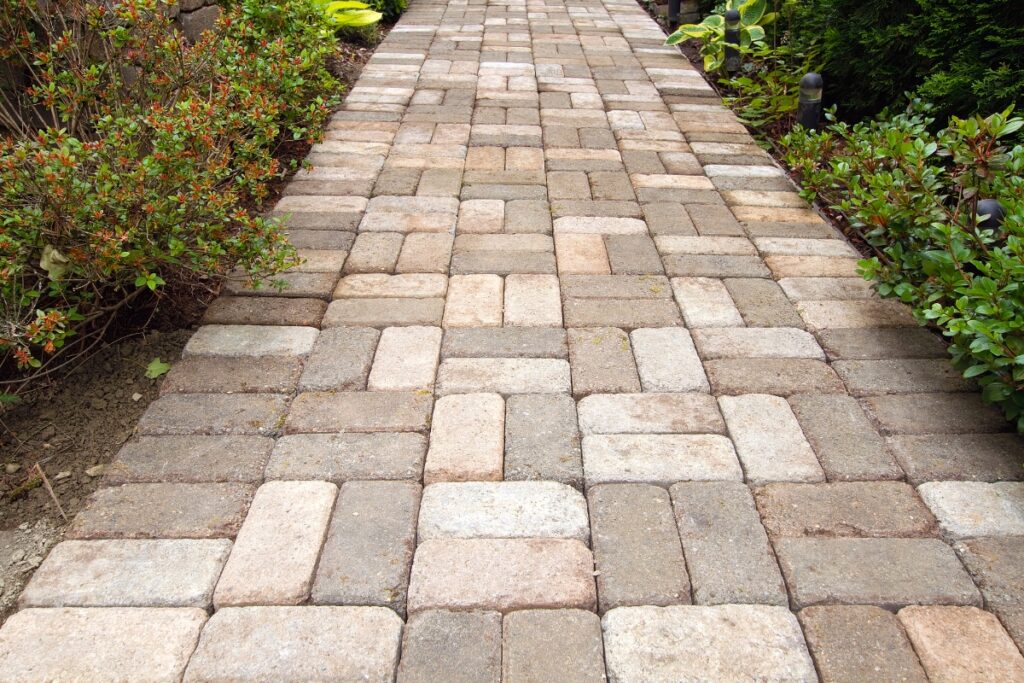
For those who appreciate the raw beauty of natural materials, stone pavers are an excellent choice for building a stunning garden path. These durable and versatile stones come in a variety of colors and textures, allowing you to create a path that harmonizes with the natural elements of your yard.
Stone pavers can be made from materials such as limestone, sandstone, or granite. Each type of stone has its own unique characteristics, ranging from smooth and polished to rough and rustic.
When selecting stone pavers for your garden path, consider the overall aesthetic you wish to achieve. If you prefer a more formal look, opt for uniform-sized stones with clean lines. For a more organic feel, choose irregularly shaped stones that mimic the randomness of nature.
To install stone pavers in your garden path, start by preparing the ground. Remove any vegetation or debris and level the area. Then, lay down a base layer of compacted gravel or sand to provide stability for the stones.
Next, arrange the stone pavers in your desired pattern, making sure they fit snugly together. Fill in the gaps between the stones with sand or gravel, sweeping it into place until it is level with the tops of the pavers.
Maintaining a garden path with stone pavers is relatively low maintenance. Regularly sweep away debris and remove any weeds that may grow between the stones. You can also use a pressure washer to remove dirt and grime if necessary.
A garden path adorned with natural stone pavers adds an air of elegance and sophistication to your outdoor space. It allows you to embrace the beauty of Mother Nature while creating a functional and visually appealing pathway through your yard.
Gravel Paths: Achieving a Rustic and Low-Maintenance Design

If you’re looking for a low-maintenance option that exudes rustic charm, consider building a garden path with gravel. Gravel paths are easy to install and require minimal upkeep, making them an ideal choice for busy homeowners or those who prefer a more relaxed and informal aesthetic.
Gravel comes in various sizes and colors, allowing you to customize your garden path to suit your personal taste and the overall style of your yard. From small pebbles to larger stones, there is a wide range of options to choose from.
When designing your gravel path, consider the size of the stones you want to use. Smaller stones create a smoother surface that is easier to walk on, while larger stones add texture and visual interest.
To build a garden path with gravel, start by preparing the ground. Remove any existing vegetation or debris and level the area. Then, lay down a base layer of compacted gravel or sand to provide stability for the stones.
Next, spread a layer of gravel on top of the base layer, making sure it is evenly distributed. Use a rake or shovel to smooth out the surface and create an even walking area.
Maintaining a garden path with gravel is relatively simple. Periodically rake the surface to redistribute the stones and remove any weeds that may grow through. You can also add additional gravel as needed to maintain an even walking surface.
A garden path adorned with gravel adds a rustic touch to your outdoor space while providing functionality and ease of maintenance. It blends seamlessly with natural elements such as plants and trees, creating a harmonious environment that invites relaxation and contemplation.
Wooden Walkways: Infusing Warmth and Organic Appeal

If you’re looking for a material that infuses warmth and organic appeal into your garden path, wooden walkways are an excellent choice. These natural and versatile paths blend seamlessly with any outdoor environment, creating a sense of harmony and tranquility.
Wooden walkways can be made from various types of wood, including cedar, redwood, or even reclaimed lumber. Each type of wood has its own unique characteristics, ranging from rich hues to distinctive grain patterns.
When selecting wood for your garden path, consider the level of maintenance you are willing to undertake. Hardwoods such as teak or ipe are more resistant to rot and decay but may require periodic sealing or staining. Softwoods like cedar or redwood are naturally resistant to insects and decay but may require more frequent maintenance.
To build a wooden walkway in your garden, start by preparing the ground. Remove any vegetation or debris and level the area. Then, lay down a base layer of compacted gravel or sand to provide stability for the wooden planks.
Next, arrange the wooden planks in your desired pattern, making sure they are secure and level. You can choose to leave gaps between the planks for a more rustic look or place them close together for a smoother walking surface.
Maintaining a garden path with wooden walkways requires regular upkeep to ensure their longevity. Periodically inspect the wood for signs of rot or decay and replace any damaged planks as needed. You should also clean the surface of the wood regularly and apply a protective sealant or stain every few years.
A garden path adorned with wooden walkways adds warmth and character to your outdoor space while providing functionality and natural beauty. It creates an inviting atmosphere that beckons you to explore nature’s wonders at your own pace.
Concrete Slabs: A Sleek and Modern Approach to Garden Paths

If you prefer a sleek and modern aesthetic for your garden path, concrete slabs are an excellent choice. These versatile and durable materials create clean lines and a minimalist look that complements contemporary outdoor spaces.
Concrete slabs come in various sizes, shapes, and finishes, allowing you to customize your garden path to suit your personal style and the overall design of your yard. From smooth and polished surfaces to textured or stamped patterns, there is a wide range of options to choose from.
When designing your concrete path, consider the size and shape of the slabs you want to use. Larger slabs create a more dramatic effect and require fewer joints, while smaller slabs allow for more intricate patterns and flexibility in design.
To install concrete slabs in your garden path, start by preparing the ground. Remove any vegetation or debris and level the area. Then, lay down a base layer of compacted gravel or sand to provide stability for the slabs.
Next, place the concrete slabs in their designated spots, making sure they are secure and level. Use a rubber mallet or hammer to tap them into place if necessary.
Maintaining a garden path with concrete slabs is relatively low maintenance. Regularly sweep away debris and remove any weeds that may grow between the joints. You can also use a mild detergent solution or pressure washer to clean the surface of the slabs if necessary.
A garden path adorned with concrete slabs adds a sleek and modern touch to your outdoor space while providing functionality and durability. It creates a sense of order and sophistication that complements contemporary architecture and design.
Mosaic Tiles: Unleashing Your Artistic Side in Landscape Design
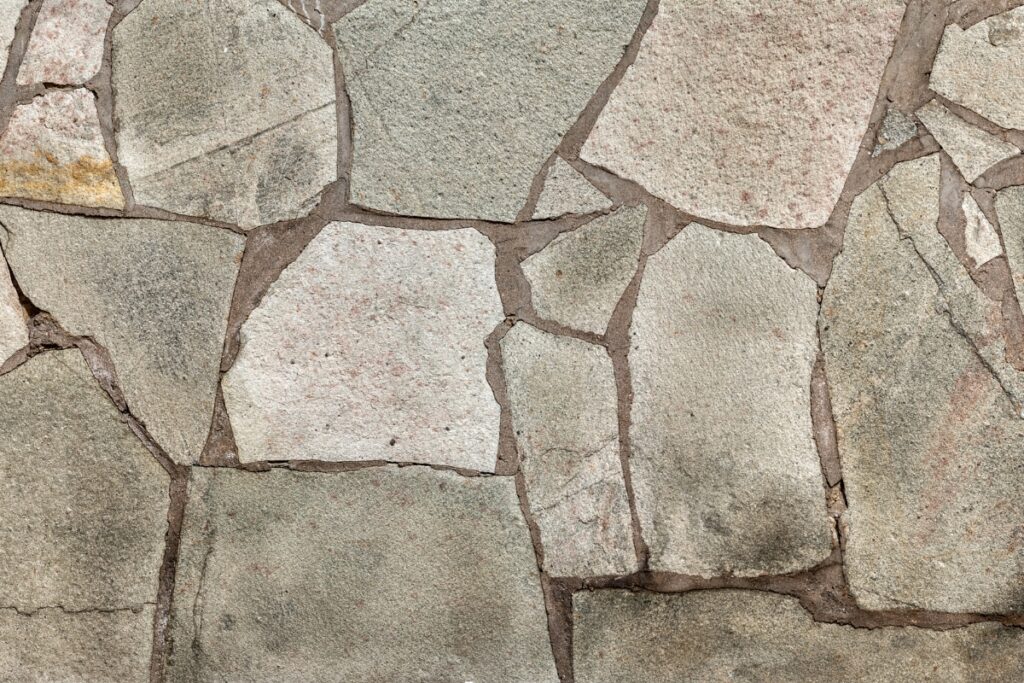
If you’re looking to unleash your artistic side in landscape design, consider using mosaic tiles for your garden path. These vibrant and eye-catching materials allow you to create unique patterns, intricate designs, and personalized artwork that transform your outdoor space into a work of art.
Mosaic tiles come in various colors, shapes, and sizes, allowing you to let your creativity run wild. From bold and geometric patterns to delicate floral motifs, the possibilities are endless.
When selecting mosaic tiles for your garden path, consider the overall aesthetic you wish to achieve. If you prefer a more cohesive look, choose tiles in similar colors or patterns. For a more eclectic feel, mix and match different styles for a truly one-of-a-kind design.
To install mosaic tiles in your garden path, start by preparing the ground. Remove any vegetation or debris and level the area. Then, lay down a base layer of compacted gravel or sand to provide stability for the tiles.
Next, arrange the mosaic tiles in your desired pattern or design, making sure they fit snugly together. Use tile adhesive or mortar to secure them in place and fill in the gaps between the tiles with grout.
Maintaining a garden path with mosaic tiles requires regular upkeep to ensure their longevity and vibrancy. Periodically inspect the tiles for any signs of damage or loose pieces and repair them as needed. You should also clean the surface of the tiles regularly using mild detergent and water.
A garden path adorned with mosaic tiles is a true expression of your artistic vision. It adds color, texture, and personality to your outdoor space while providing functionality and visual interest that will leave your guests in awe.
Pathway Lighting: Illuminating Your Garden Path with Style

Pathway lighting is an essential element when it comes to building a stunning garden path. Not only does it provide safety and visibility during nighttime strolls but it also adds ambiance and style to your outdoor space.
There are various types of pathway lighting to choose from, including solar-powered lights, LED fixtures, or even traditional lanterns. Each type of lighting has its own unique characteristics and benefits.
Solar-powered lights are an eco-friendly option that harnesses the power of the sun to illuminate your garden path. They are easy to install and require minimal maintenance. LED fixtures are energy-efficient and long-lasting, providing bright and focused light along your pathway. Traditional lanterns add a touch of nostalgia and charm, creating a warm and inviting atmosphere.
When designing your pathway lighting, consider the overall aesthetic you wish to achieve. If you prefer a more subtle look, opt for lights that blend seamlessly with the surrounding landscape. For a more dramatic effect, choose fixtures that stand out and become a focal point in their own right.
To install pathway lighting in your garden path, start by planning the layout. Determine where you want to place the lights along your pathway and mark their positions accordingly.
Next, dig small holes or trenches along the designated spots for the lights. Install the lights according to the manufacturer’s instructions, making sure they are secure and level.
Maintaining pathway lighting is relatively simple. Regularly check the bulbs or solar panels for any signs of damage or wear and replace them as needed. You should also periodically clean the fixtures to remove dirt or debris that may accumulate over time.
Pathway lighting not only illuminates your garden path but also adds a touch of style and sophistication to your outdoor space. It creates an enchanting atmosphere that invites you to explore nature’s beauty even after sunset.
Incorporating Water Features: Enhancing the Serenity of Your Garden Path

If you’re looking to create a truly serene environment in your garden path, consider incorporating water features into your design. The soothing sound of flowing water adds a sense of tranquility and relaxation, transforming your outdoor space into a peaceful sanctuary.
There are various types of water features to choose from, including fountains, ponds, or even small cascades. Each type of feature has its own unique characteristics and benefits.
Fountains create a focal point in your garden path while providing the calming sound of trickling water. Ponds add a touch of nature and allow you to incorporate aquatic plants and fish into your design. Cascades create a dramatic effect as water flows down multiple levels, creating a visual spectacle.
When incorporating water features into your garden path, consider the overall aesthetic you wish to achieve. If you prefer a more natural look, opt for materials such as stone or pebbles that blend seamlessly with the surrounding landscape. For a more contemporary feel, choose sleek and modern designs that stand out.
To install water features in your garden path, start by planning the layout. Determine where you want to place the feature along your pathway and mark its position accordingly.
Next, dig a hole or trench for the feature’s basin or reservoir. Install the feature according to the manufacturer’s instructions, making sure it is secure and level.
Maintaining water features requires regular upkeep to ensure their functionality and cleanliness. Periodically check the pump or filtration system for any signs of damage or clogging and repair or clean them as needed. You should also clean the basin or reservoir regularly to remove debris or algae that may accumulate over time.
Incorporating water features into your garden path enhances its serenity and beauty. It creates an oasis-like atmosphere that transports you to another realm where peace and tranquility reign supreme.
Mixing Materials: Creating a Unique and Personalized Garden Path
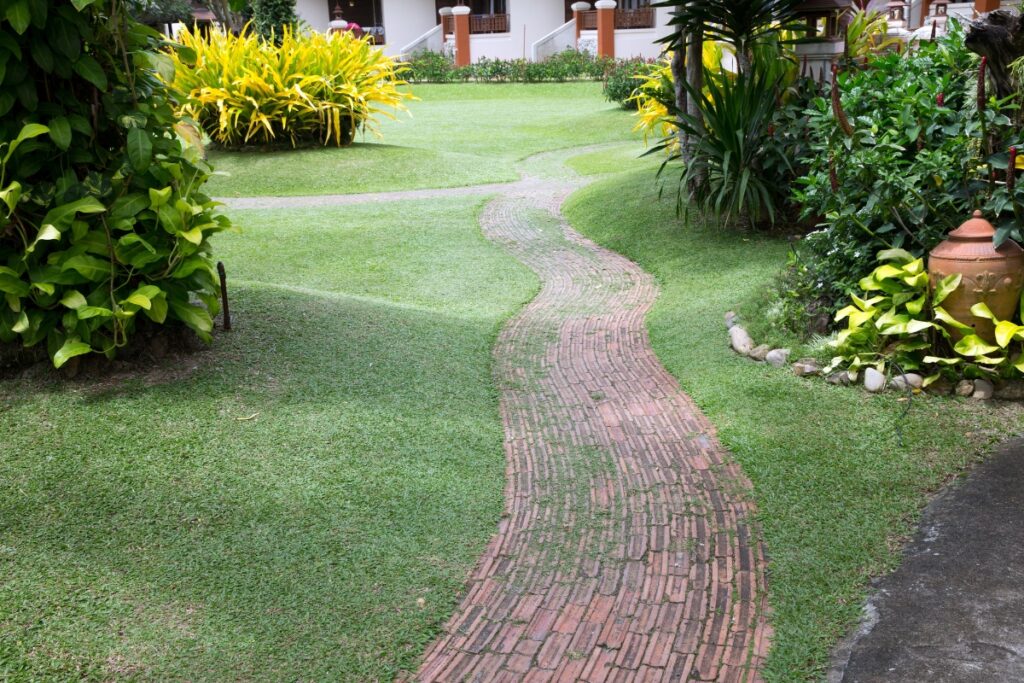
If you’re feeling adventurous and want to create a truly unique and personalized garden path, consider mixing materials in your design. Combining different textures, colors, and shapes adds visual interest and allows you to showcase your creativity.
When mixing materials, the possibilities are endless. You can combine cobblestones with gravel for a rustic yet low-maintenance look. Or pair wooden walkways with mosaic tiles for a blend of warmth and artistic flair. You can even mix concrete slabs with natural stone pavers for a sleek and modern design.
When designing your mixed-material garden path, consider the overall aesthetic you wish to achieve. Choose materials that complement each other in terms of color, texture, or style. Experiment with different combinations until you find the perfect balance.
To install mixed materials in your garden path, start by preparing the ground. Remove any vegetation or debris and level the area. Then, lay down a base layer of compacted gravel or sand to provide stability for the different materials.
Next, arrange the materials in your desired pattern or design, making sure they fit together seamlessly. Use appropriate adhesives or fillers to secure them in place and create a cohesive look.
Maintaining a garden path with mixed materials requires regular upkeep to ensure their longevity and visual appeal. Periodically inspect each material for signs of damage or wear and repair or replace them as needed. You should also clean the surface regularly using appropriate cleaning methods for each material.
A garden path adorned with mixed materials is a true reflection of your personal style and creativity. It adds character and individuality to your outdoor space while providing functionality and beauty that will leave a lasting impression on all who visit.
Conclusion: Transforming Your Yard into a Captivating Sanctuary
Building a stunning garden path is an opportunity to transform your yard into a captivating sanctuary. By carefully selecting materials, considering their aesthetics and functionality, and incorporating unique elements such as lighting or water features, you can create a pathway that not only guides you through nature’s beauty but also becomes a work of art in its own right.
Whether you choose classic cobblestones for timeless elegance, whimsical stepping stones for a touch of charm, or natural stone pavers to embrace the beauty of Mother Nature, each material offers its own unique benefits and aesthetic appeal.
Gravel paths provide a rustic and low-maintenance design option, while wooden walkways infuse warmth and organic appeal into your outdoor space. Concrete slabs offer a sleek and modern approach, while mosaic tiles unleash your artistic side in landscape design.
Pathway lighting illuminates your garden path with style, while incorporating water features enhances the serenity of your outdoor space. And by mixing materials, you can create a truly unique and personalized garden path that reflects your individuality.
So why wait? It’s time to roll up your sleeves, put on your gardening gloves, and embark on an adventure filled with inspiration and beauty. Transform your yard into a captivating sanctuary with a stunning garden path that will leave both you and your guests in awe.
Remember to let your creativity soar as you explore the endless possibilities that landscape design has to offer. Building a garden path is not just about getting from point A to point B; it’s about creating an experience that awakens your senses and connects you with the wonders of the natural world.
A well-designed pathway not only enhances the aesthetic appeal but also invites a sense of tranquility and exploration. At Glover Landscapes, we specialize in turning such visions into reality, ensuring that every step you take in your garden is a delightful experience.
Ready to bring your dream garden path to life? Reach out to Glover Landscapes at (404) 510-6437 or via email at [email protected] to request a free estimate. Let us partner with you in creating a landscape that resonates with beauty and functionality. Choose Glover Landscapes for a journey that begins with a single step on your stunning garden path.
So go ahead – start building your dream garden path today!
